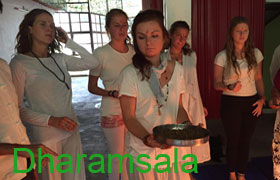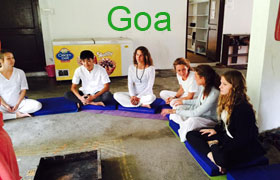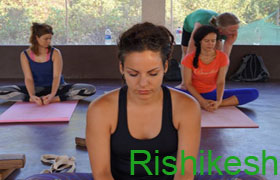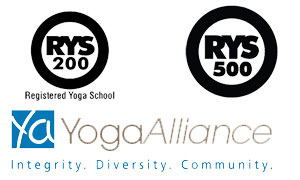Antaranga Yoga
Dharana
देशबांधश्चित्तस्य धारण – (योगदर्शन २/१) – deha means physical body and bandh means attachment. Thus concentration of mind on any part of the physical body is called as dharana.
भुमिरपोअनलो वायुराकाशशचेति पंचकः |
येशु पञ्चसु देवानां धारणा पंचदोच्यते || (योगतत्वोपनिषद)
There are five gross elements in our physical body. In other words our body is built with these pancha mahabhutas. Prudvitatva (earth element) is related to mooladhara chakra, jal tatva (water element) is related to swadhistana chakra, agni tatva (fire element) is related to manipura chakra, vayu tatava (air element) is related anahath chakra and akash tatava (ether) is related vishuddhi chakra. Concentrating on any one of these elements or chakras is called dharana.
Dhyana
Asan makes the body stable while bandhas and mudras strengthen it and pranayama makes the body feel lighter as it cleanses the nadis. Practice of dharana exterminates the versatility of mind. It promotes the stability of mind. Thus asan, mudras and bandhas should be practiced after the practice of pranayama and dharana to achieve proficiency in this arena. The yoga teacher training in Dharmasala offers a proficient training of pranayama.
According to Swami Vivekanand Maharaj if we can concentrate on any element continuously for 12 seconds without any deflection it is called as dharana. If we can continue to concentrate on it for twelve times the dharana i.e., for 144 seconds, it is considered as dhyana. If we still continue to concentrate for twelve times such dhyana i.e., for 1728 seconds, it constitutes for Samadhi.
तत्र प्रत्यैकतानता ध्यानम्
It means to focus on the dharana (concentration) of mind and maintaining the focus without being disturbed or affected by any other instinct is called dhyana. Dhyana is of two types – sthul dhyana and sukshma dhyana. Sthul dhyana is all about meditating over Lord Krishna or Lord Rama or Lord Shiva or Lord Hari or Lord Gayatri Devi. Sukshma dhyana deals with focusing all the energy of the mind on completely only on brahma or atma.
One should make a point to start dhyana when inhalation and exhalation takes place through sushumna nadi that is through both the nostrils simultaneously. Generally inhalation and exhalation takes place through ida nadi i.e through left nostril for some time and through pingala nadi i.e., through right nostril for some time. This process takes place for about one and half to two hour of time. After this, breath changes its course from pingala to ida (right to left) and ida to pingala (left to right) for some time. During this process of changing, respiration continues to happen through both the nadis for a while. This process is called sandhi or sandhyakaal. This is the point where inhalation and exhalation takes place through sushumna nadi. This causes for the promotion of satv gun, while rajogun and tamogun lie dormant during this time. Therefore this point of time proves to be the best for the commencement of dhyana.
Generally when an individual begins to meditate, he is observed to be continuously disturbed by the flow of various thoughts. But there is no need to be worried. This phenomenon is very natural to occur because, the mind is left to its will to wander anywhere until now. Thus it objects the new rules imposed on it all of a sudden. But if the individual continues to meditate without paying any attention to the acts of mind, this phenomenon will disappear naturally. And eventually he can enter into dhyana and Samadhi states. The yoga teacher training in Goa can train you very well with the techniques of meditation.
To start to meditate one should sit in padmasana and try to concentrate on Mediterranean point. The individual should try to impose any kind of pressure on mind. He should try to continue to do this for atleast half a minute. This law of practice should be gradually increased to upto half an hour. The individual should be mindful to ease the pressure on his mind during the practice and should not allow even the slightest tension on mind. This practice enables us to attain control over the flickering nature of the mind. Based on one’s interest, behaviour and ability to practice, one can chose either nasikagra bindu or bhumadhya bindu for the point of concentration.
A vedantic seeker tends to focus his mind on his aatma (soul) in order to move ahead. The seekers of hath yoga and raj yoga tries to concentrate over the six chakras residing in the body. Devotees surrender their mind and soul to the deity of their choice. Thus concentration is common and most essential requirement for any seeker.
If an individual intends to progress in the practice of meditation, he should try to achieve control over his tongue. He should always speak sweetly. He should speak only truth in every situation. He should never speak anything which would hurt others mentally or emotionally. He should be mindful to analyses the impact his words would have on others before uttering them. He should try to talk as less as possible. This is called as vak-tapas. This will eventually save your energy and fill him with mental peace and inner peace.
The soul needs prayer, jap, keertan and dhyana similar to the way the body needs food for its survival. The soul tends to experience anxiety when an individual does not bother to pray or recite any hymns in the morning or evening similar to the body which experience anxiety when it does not get food in time. Thus soul should also be provided with its food in time. Infact, soul has more necessity of its food than the body. Thus one should practice prayer, jap , dhyana etc in a disciplined manner. The individual should practice pranayama before proceeding into dhyana as it would enable the seeker with complete control over mind which is very essential for the practice of dhyana.




